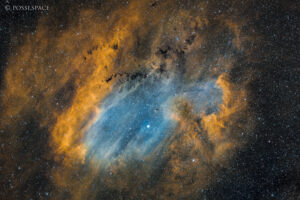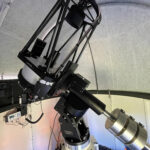A field report after photographic acquisition of five different celestial objects.
From Dr. Claus Possberg, Freyung Observatory (www.possi.space) – October 2022
The use of ultra-highspeed systems such as Celestron RASA, Hyperstar, or special astrographs has revolutionized the acquisition of faint nebular objects in recent years, but requires a special filtering technique that I would like to discuss here.

The private observatory of the author Claus Possberg, also to be found with further information on our observatory world map
An emission line, such as H-alpha at 656.28 nanometers, optimally experiences very little attenuation when passing through a line filter in the central beam. The world's best filters achieve a good 90% transmission here. However, if the beam passes through the periphery of the telescope system, the emission line shifts slightly toward shorter wavelength light (blueshift). If the filters have a very narrow-band transmission characteristic, the wavelength moves from the maximum of the transmission curve toward the slope, undesirably attenuating the beam. The popular photonewtons, which usually have a luminous intensity of f4, are not yet so wide open that the edge rays are significantly weakened even with very narrowband filters (3nm). Such narrowband line filters are in principle especially desirable when doing astrophotography in a not perfectly dark environment (due to light pollution or moonlight) – almost every astrophotographer is affected by this at some point, because really stable clear nights are not too common in our latitudes.
When using extremely fast system (I use a Celestron RASA 36 with aperture f/2.2 in a Bortle 3-4 sky) the blueshift is already so pronounced that towards the edge of the telescope the rays are first attenuated, near the edge they are completely suppressed. Since reflecting telescopes in principle have no central beam – at the RASA e.g. the camera is mounted here – in principle all beams are more or less "edge beams" with differently pronounced blueshift. In former times one had helped oneself by using line filters with a wide "window" (e.g. 12nm or more half-width), so that the edge rays are not yet extinguished. However, such wide line filters also let through a lot of light pollution.
 Note from Baader Planetarium:
Note from Baader Planetarium:We have detailed the preshift issue mentioned here and the resulting conclusions in the following blog post and whitepaper.A filter selector tool to find the right filter for your telescope can be found at www.baader-planetarium.com/en/preshift
A better possibility is a so-called "preshift", where the center frequency of the line filter is shifted slightly towards blue (usually between 1.5 and 3nm). Special filters for high speed systems use this technique nowadays. The new
 Baader 3.5 / 4nm f/2 Ultra-Highspeed Filter-Set – CMOS-optimized (H-alpha / O-III / S-II)
Baader 3.5 / 4nm f/2 Ultra-Highspeed Filter-Set – CMOS-optimized (H-alpha / O-III / S-II) (various versions available)
combine this for the first time with a very narrow half-bandwidth of only 3.5nm (for H-alpha) or of 4nm (for SII and OIII). With such narrow passbands, the magnitude of the blueshift and thus the center frequency of the filter must be matched exactly to the light intensity of the telescope – otherwise the edge rays or even the rays close to the center are cancelled out. Baader also had to learn this lesson, because customers using a telescope with a luminous intensity of e.g. f/3.2 already suffered from significant light loss in the more central rays. The problem could only be solved in a physically correct way by Baader's recent addition of another version "f/3" filters, recommended for fast optical systems from f/3.4 to f/2.3.
Baader 3.5 / 4nm f/2 Ultra-Highspeed Filter-Set – CMOS-optimized (H-alpha / O-III / S-II)
Baader 3.5 / 4nm f/2 Ultra-Highspeed Filter-Set – CMOS-optimized (H-alpha / O-III / S-II) (various versions available)
combine this for the first time with a very narrow half-bandwidth of only 3.5nm (for H-alpha) or of 4nm (for SII and OIII). With such narrow passbands, the magnitude of the blueshift and thus the center frequency of the filter must be matched exactly to the light intensity of the telescope – otherwise the edge rays or even the rays close to the center are cancelled out. Baader also had to learn this lesson, because customers using a telescope with a luminous intensity of e.g. f/3.2 already suffered from significant light loss in the more central rays. The problem could only be solved in a physically correct way by Baader's recent addition of another version "f/3" filters, recommended for fast optical systems from f/3.4 to f/2.3.
The f/2 Ultra-Highspeed Filters in use

IC1318 Sadr Region: Mosaic 2x4 with 2.03 Gbyte original file size stacked and fused in APP. Exposure time together 22,6h (24 Panes with 60' each, 95% of them computed. HSO with own palette). Camera ZWOO ASI6200MM PRO with Baader f2 high speed narrowband filters. Download Full JPG Size: 15MB, 20.000px Seitenlänge
For my RASA 36 (f/2.2) I used a test set of the version "f/2 UNB" with 50.4mm diameter. This version is recommended for extremely fast optical systems of faster than f/2.3, but might not work for f-stops even faster than f/1.8 (extremely fast photo lenses for example).
I had the opportunity – my thanks go to Tobias Baader for the long test period – to test the new filters without any specifications for about two months and took pictures of five different objects with them (pictures see below). For comparison I also had a HSO set of 6nm Astronomik "FR" here, which also show a blueshift, but are just not as narrowband.
I attach some results as examples for the new Baader "f/2" filters. I would like to list here the properties that the new filters exhibit in my images:
- very narrow band, very little light pollution comes through. This is especially important for the OIII filter. In this point better than 6nm wide filters
- hardly any light loss with the ultra-fast system in all three lines
- very low halo tendency. A hint of halo can be found only at extremely bright stars
- no reflections (at least I did not notice any)
- blackened edges also reduce internal reflections
- special coating seals the edges (still extreme caution - avoid bumping and fingerprints)
- H-alpha and SII are parfocal, OIII has to be refocused (doesn't matter for RASA, since a filter slider has to be used anyway, since there is no room for a filter turret)
- Individual measurement protocols were not included. The customer must trust that there is no significant specimen scatter.
- like all high quality narrow band filters expensive (but in my view still competitively priced). In return, the narrowest line filters for ultra-fast systems on the current market with the best stray light suppression.
Conclusion:
I have personally decided that I will keep these excellent new filters. The high quality 6nm filters I have used so far will be sold.
Text and Images: © Dr. Claus Possberg, Freyung Observatory (www.possi.space) – October 2022

SH2-115 and Abell 71: Narrowband image Hubble II (modified), ASI6200MM PRO as 2x1 mosaic, altogether 15.6h exposure time in three nights, 12.5h of it offset. Good seeing 1,2...1,4".

SH2-119: Narrow band Hubble II (modified), ASI6200MM PRO, total 17.6h exposure time in four nights, of which 14.1h (80%) offset. Good, at times very good seeing 1.2...1.5".

SH2-134: Narrowband image RGB palette (modified), ASI6200MM PRO, total 11.1h exposure time in three nights, of which 8.9h (80%) offset. Good, at times very good seeing 1.2...1.5".








